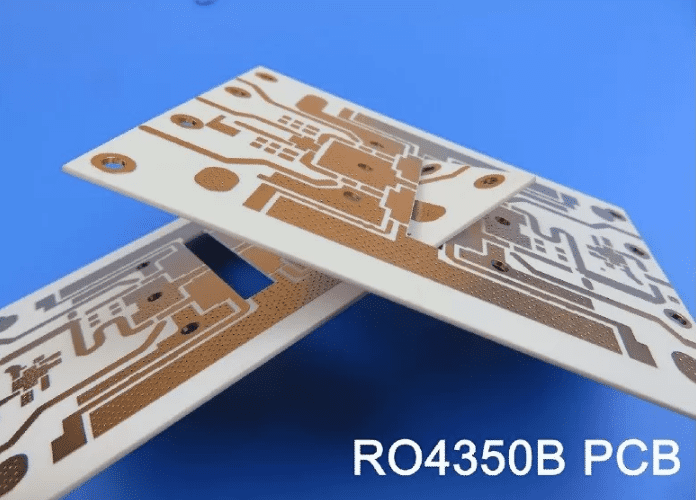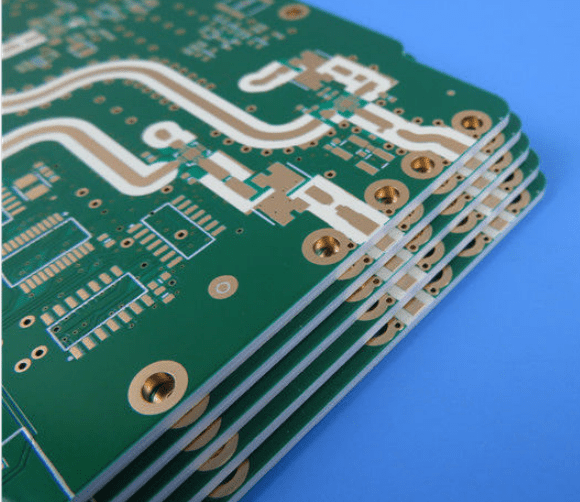The type of materials or laminates used for circuits factor into the overall performance of these circuits. That is why circuit board manufacturers are particular about using the right type of laminates or materials for the board customizations.
Out of the many options out there, one of the best laminates you can use for your projects is the Rogers 4350. In this article, we explain the major things you need to know about how it works.
What is Rogers 4350?
Also called the Rogers 4350B, it is a circuit board material featuring proprietary woven glass reinforced hydrocarbon and ceramics. One of the core attributes of the Rogers 4350 is the composition of the manufacturability of the epoxy/glass and the proximity of the electrical performance to the woven glass/PTFE.

The Family of Laminates
The Rogers 4350 belongs to the Rogers RO4000 series of laminates or circuit board materials. According to the information on the whitepaper, the RO4000 series are optimized to be high-frequency circuit materials, which are primarily used to reduce the overall costs of fabricating the circuits.
Why Choose the Rogers 4350?
With many circuit board laminates out there, why should you settle for the Rogers 4350? Here are some of the reasons why buying this circuit material for your next project could be worth it:
Rogers 4350 Offers Excellent Dimensional Stability
It is no news that some circuit materials or laminates tend to operate haphazardly when they go beyond certain dimensions. That doesn’t appear to be the case with the Rogers 4350, which maintains an excellent dimensional stability of <0.5.
It is to be noted that the dimensional stability of a circuit material has certain roles to play in the circuit’s overall performance. By the exhibition of an excellent dimensional stability, the Rogers 4350 proves to be a better option for use with the mixed dielectric multilayered board constructions.
Rogers 4350 as a Drop-in Replacement
There are different types of circuit materials broadly categorized under the Rogers RO4000 series. One of such is the Rogers 4350 and the other is the Rogers RO4003C.
However, the Rogers 4350B is designed to be a drop-in replacement for the Rogers RO4003C circuit material. The replacement capability is because the Rogers 4350 circuit material uses the RoHS-compliant flame-retardant technology, which is ideal for the applications that require or are meant to comply with the UL 94V0-Certification.
Circuit Board Optimization
The Rogers 4350, also called the RO4350B circuit material, is ideal for use with specific circuit boards. These boards are the double-sided and the multilayered Printed Wiring Boards (PWBs).
For that purpose, the material is expected to function in specific ways. Below are some of the circuit processing guidelines for the Rogers 4350, when being used with either the multilayered or the double-sided Printed Circuit Boards (PCBs).

Drilling Information
Rogers 4350 is compatible with drilling, but specific measures have to be in place. These are some of the things you need to know about drilling this circuit board material:
Understanding the Chip Loads
The chip loads used when drilling the Rogers 4350 should comply with the diameter drills. It is for this reason that the manufacturer recommends using a lower chip load of about <0.002” for the small (<0.0135”) diameter drills.
The manufacturer also recommends using a chip load greater than 0.002” for both the large and mid-range diameter tools.
Preparing the Inner Layer of the Rogers 4350 Circuit Board Material
The preparation processes for the inner layers of the RO4350B cover the tooling options, the bonding of the layers, the preparation of the surface and the treatment options.
Here is a detailed breakdown of what goes into the inner layer preparation of the RO4350B circuit material:
Tooling Options
The best tooling methods for the Rogers 4350 material are both the pinless and the pinned tooling methods. While the tooling methods or options are many, you don’t want to make the mistake of overlooking important metrics, such as the capabilities of the circuit facility. Considerations are also to be made about the final registration requirements.
To that end, you want to put the following into consideration when deciding on the best tooling methods for the Rogers 4350 material:
- Standard vs. multiline tooling
- Slotted or round pins
- Pre vs. post-etch punching
- Internal or external pinning
However, the manufacturer, Rogers, suggests using post-etch punching, slotted pins and the multiline tooling options, because the trio meet most of the circuit design needs.
Oxide Treatment and Bonding
The oxide treatment option for the Rogers 4350 should also align with the bonding option. According to the manufacturer, the “cores of the Rogers 4350 can be processed through any copper oxide or oxide alternative process in preparation for multi-layer bonding.”
However, it is also pertinent to take note of the treatment option, as it has to should support either the adhesive system or the prepreg, as specified in the recommended guidelines.
As for the multi-layer bonding, the RO4350B material is compatible with several thermoplastic and thermosetting adhesive systems. However, you also want to check the guidelines of the adhesive system before going ahead with it.
Surface Preparation
The surface preparation for photoresist and copper etching are worth considering when working with the Rogers 4350. As per the information in the datasheet/processing guidelines, the copper surfaces and the core thickness of the material can be prepared for photo imaging, using either the mechanical or the chemical processes.

However, it is also possible to divide or break down the processes, depending on what is involved. For example, the thicker cores of the Rogers 4350 should have the surfaces prepared with the thinner cores can be surface-prepared with the chemical processes. Examples of the chemical processes are:
- Drying
- Cleaning
- Water rinsing and;
- Micro-etching
Final Words
Rogers 4350, otherwise called RO4350B circuit material, is an ideal material for Printed Circuit Boards (PCBs) that require tighter control on the Dielectric Constant (Dk), while helping to maintain low loss for the circuits.
The final circuitization processes for the RO4350B range from individualization, such as punching, dicing, routing, sawing and shearing. Other options include breakaway tabs and V-scoring to individualize the circuits after automating the assembly process.
Comments are closed